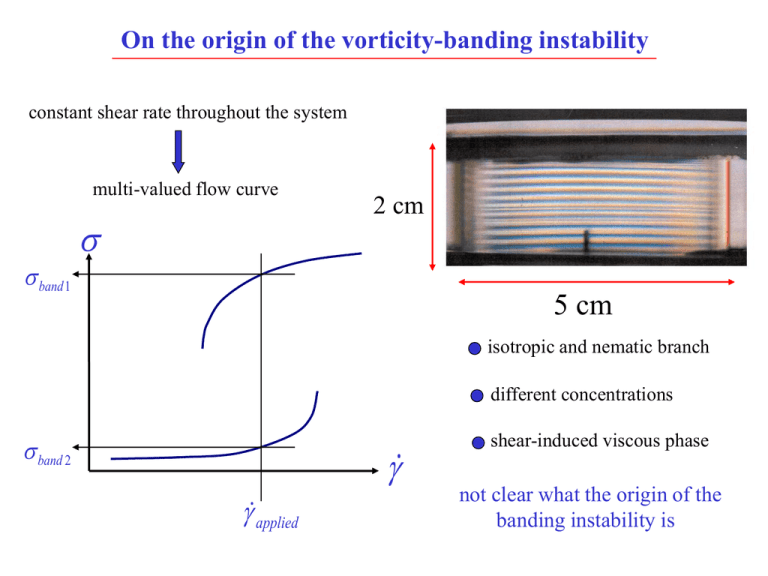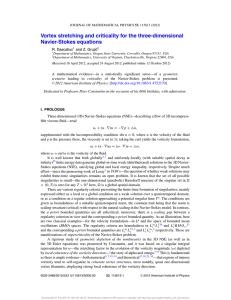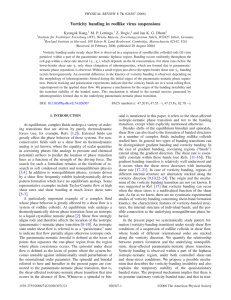5 cm
advertisement

On the origin of the vorticity-banding instability constant shear rate throughout the system multi-valued flow curve band 1 2 cm 5 cm isotropic and nematic branch different concentrations band 2 applied shear-induced viscous phase not clear what the origin of the banding instability is rolling flow within the bands normal stresses along the gradient direction normal streses generated within the interface of a gradient-banded flow low high ( S. Fielding, Phys. Rev. E 2007 ; 76 ; 016311 ) L = 880 nm D = 6.7 nm P = 2200 nm fd virus : Critical point Binodal . 2 -1 1 [[s s ]] Spinodals ( P. Lettinga ) Vorticity banding 11 Tumbling wagging 0 0 0.0 0.2 concentration concentration 1 0.4 0.6 j 0.8 nem 1.0 j almost crossed polarizers distinguish orientational order vorticity direction P 100 m A 2 3 4 5 ~ 1 mm 1 6 7 H[m] 8 120 stretching of 100 inhomogeneities vorticity direction 80 A growth of bands 60 1 0 2 10 3 4 20 5 30 6 7 8 40 50 60 Time [min] t t0 H (t ) H 0 A 1 exp Gapwidth 2.0 mm Shear flow N heterogeneous vorticity banding band width growth rate interconnected A disconnected H0 t t0 H (t ) H 0 A 1 exp 23 % : A finite; 35 % : A 0; finite spinodal decomposition : j nem 0.23 nucleation and growth : j nem 0.75 100 m ( with Didi Derks, Arnout Imhof and Alfons van Blaaderen ) tracking of a seed particle ( counter-rotating couette cell ) with Bernard Pouligny (Bordeaux) elastic instability for polymers : equidistant velocity lines non-uniform deformation 100 H [m] 90 80 70 60 1.0 1.5 2.0 2.5 G [mm] Weissenberg or rod-climbing effect K. Kang, P. Lettinga, Z. Dogic, J.K.G. Dhont Phys. Rev. E 74, 2006, 026307-1 – 026307-12 New viscous phases can be induced by the flow (under controlled shear-rate conditions ) inhomogeneous new phase stress shear rate homogeneous personal communication with John Melrose Stability analysis : discreteness of inhomogeneities along the flow direction is of minor importance : u y ( y, z , t ) u y ( y, z , t ) u y ( y, z , t ) m uy uz By ( y , z , t ) t y z mass density z-dependence gradient component of the body force exp i k z t with 2 / k the typical distance between inhomogeneities z u y ( y, z, t ) u ( y ) expik z t By ( y, z, t ) B( y) exp ik z t By F (r , uˆ, t ) “Brownian contributions” +”rod-rod interactions” probability density for the position r and orientation û of a rod linear bi-linear +“flow-structure coupling” linear û y z r x y J.K.G. Dhont and W.J. Briels J. Chem Phys. 117, 2002, 3992-3999 J. Chem Phys. 118, 2003, 1466-1478 ( r , uˆ, t ) A 0 (r , uˆ ) A ( y ) 1 ( r , uˆ, t ) “renormalized base flow probability” By 0 2 large small 4 1 2 linear contributions By ( y ) bi-linear contributions By ( y ) rod-rod interactions A( y) 4 1 2 2 A A( y ) 4 1 2 2 2 By ( y) C1 C2 A A( y) 4 4 1 1 2 2 A( y) m u ( y ) C1 C2 A 4 4 1 1 2 2 0 C1 C2 A 4 4 1 1 A 0 A 0 4 1 u 0 2 C1 0 C2 0 A C 0 A ( ) 2 A 1 ( ) 4 2 1 4 C 0 depends on the microstructural properties of the inhomogeneities l u C A 4C unstable stable AC 0.0 0.2 concentration 0.4 0.6 Bonn D, Meunier J, Greffier O, Al-Kahwaji A, Kellay H, Bistability in non-Newtonian flow : rheology and lyotropic liquid crystals, Phys. Rev. E 1998 ; 58 ; 2115-2118. Wilkins GMH, Olmsted PD, Vorticity banding during the lamellar-to-onion transition in a lyotropic surfactant Micellar worms solution in shear flow, Eur. Phys. J. E 2006 ; 21 ; 133-143. -Worms Fischer P, Wheeler EK, Fuller GG, Shear-banding structure oriented in the vorticity direction observed for equimolar micellar solution, Rheol. Acta 2002 ; 41 ; 35-44. - Entanglements - Shear-induced phase Lin-Gibson S, Pathak JA, Grulke EA, Wang H, Hobbie EK, elastic flow instability in nanotube suspensions, Nanotube bundles Phys. Rev. Lett. 2004 ; 92, 048302-1 - 048302-4. Vermant J, Raynaud L, Mewis J, Ernst B, Fuller GG, Colloidal aggregates Large-scale bundle ordering in sterically stabilized latices, J. Coll. Int. Sci. 1999 ; 211 ; 221-229. Kyongok Kang Pavlik Lettinga Wim Briels




